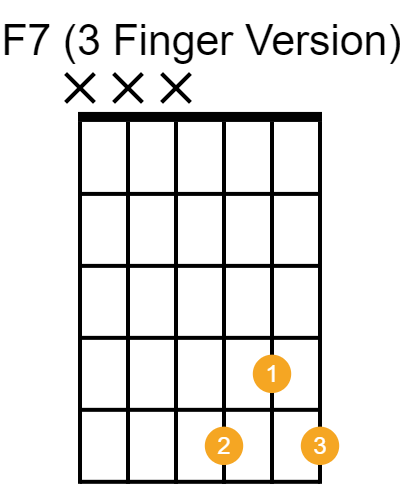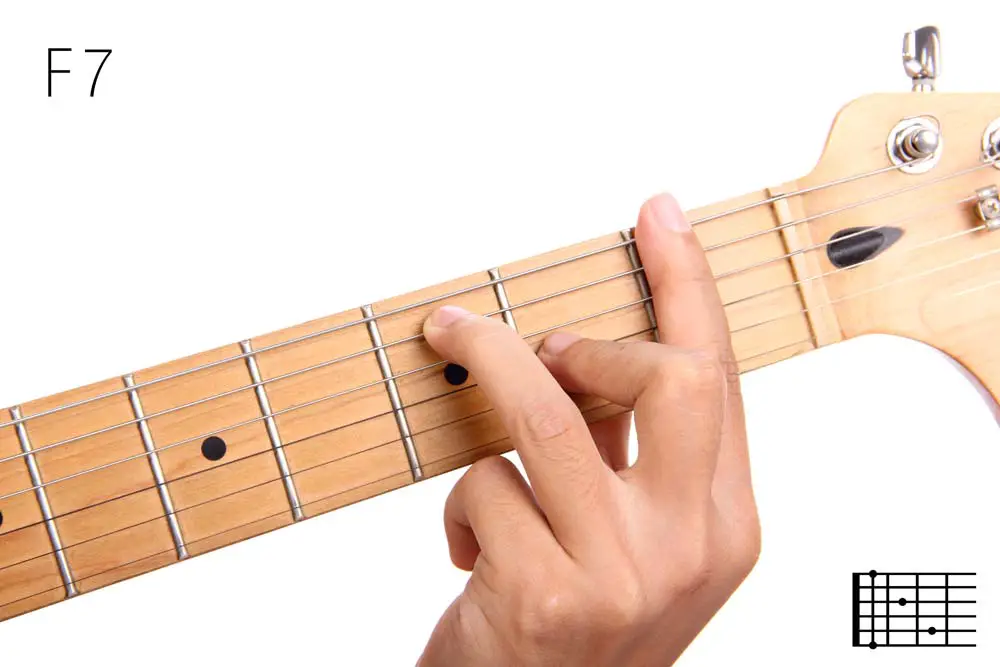If you’re a guitar beginner, you may not have given a second thought to the F dominant seventh chord. Often known as F7, it isn’t the most common, and it isn’t the easiest to play.
So why should you learn it?
F7’s sparkling texture will entice you with a single strum. When you include it in a chord sequence, this is when it’ll come to life with its powerful bluesy coloration.
7th chords offer a different feel to the majors and minors so are absolutely worth exploring. A noteworthy case in point is courtesy of the Beatles who often incorporated the 7th chords into their writing. Safe to say—it didn’t do them any harm.
Whether you’re an accomplished guitarist or just starting out, let’s add another string to your bow with the F7 chord.
Contents
Playing The F7 Guitar Chord
The most standard way to play the F7 is as a barre chord on the first fret.

To play a standard F7:
- Use your index finger to barre the 1st fret.
- Place your middle finger on the 2nd fret, G string.
- Last, place your ring finger on the 3rd fret A string.
If you’re struggling with the positioning, use the same shape as an F major barre chord. Then just lift the pinky finger away from the fretboard.
Playing The F7 Guitar Chord (without barre – easy 4 finger version)
Are you cursing at the sight of yet another barre chord? Let’s have a look at an alternative.
A word of warning, while this F7 open chord will fall into the beginner category, it’ll likely be one of the hardest chords you’ve come across. This technique requires you to stretch all fingers across four frets.
Learn this chord and you’re ready for the next stage on the journey to becoming a guitar hero.

To play an F7 (without barre):
- Place your index finger on the 1st fret of the high e string.
- Next, place your middle finger on the 2nd fret of the G string.
- Now place your ring finger on the 3rd fret of the D string.
- Finally, for the tough part, place your pinky finger on the 4th fret of the B string.
If you’re getting some muted strings, remember to arch your finger joints and play the notes on the tips of fingers.
Playing F7 Guitar Chord (no barre – easiest 3 finger version)
Did you find the last variation difficult? Don’t worry, you won’t be alone if struggling to play such a complex chord. This is a skill that’ll take time to learn.
Anyway—you’re in luck, there is another version that uses three fingers. This rootless version of an F7 chord is a bit of a cheat but is within the capabilities of all guitarists (whatever stage you’re at).

To play an F7 guitar chord (no barre – 3 finger version):
- Place your index finger on the 4th fret of the B string.
- Next your middle finger on the 5th fret of the G string
- Last, your ring finger goes on the 5th fret of the high e string.
What Notes Make The F7 Chord
Four notes comprise the F7 chord:
- F
- A
- C
- Eb (E Flat)
You may notice that this is one more than the standard three notes used in a major or minor chord. We construct dominant 7th chords with a root, a major third, a perfect fifth, and a minor seventh.
What Songs Use The F7 Chord?
Bye Bye Love by The Everly Brothers uses an F7 with great effectiveness. In this song, the F7 chord is first introduced before the chorus. A transition from an F Major to F7 is a slick way to build anticipation for the listener.
According to the 1998 Guinness Book of World Records, Happy Birthday is the most recognized song in the English language. Safe to say, it’s catchy and uses a dominant 7 chord.
Fancy giving it a go? This song will come in many keys but we transposed this version to incorporate the F7 chord:
| F | C |
| Happy Birthday to you | |
| C | F |
| Happy Birthday to you | |
| F7 | A# |
| Happy Birthday, dear (name?) | |
| F | C F |
| Happy Birthday to you | |
Conclusion
There we have it, a guide to playing the F7 chord.
Stretching four fingers across four frets is enough to daunt even accomplished guitarists, so remember, don’t stress! If you can’t grasp it right away, remain patient, keep trying, and it’ll come.
Try incorporating the barre chord into a simple sequence such as Happy Birthday. This will help you learn how to flow between barre chords.
If you’re not at that stage yet (and barre chords are still out of reach), we get it. Look at the three-finger version to get started.
Why not give this post a share? Please let us know how you get on in the comments below; we’d love to hear your feedback.



